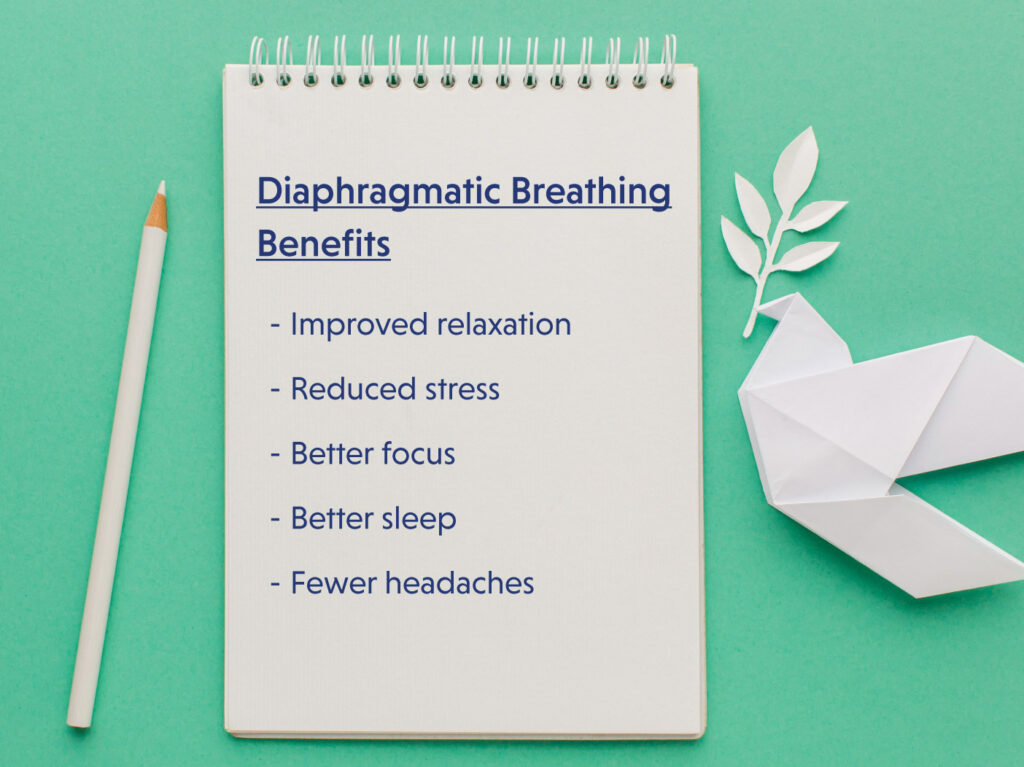Anxiety can be debilitating and overwhelming, but it doesn’t have to be. One of the best ways to control your anxiety and manage it is through diaphragmatic breathing. Diaphragmatic breathing is a powerful technique focusing on deep abdominal breathing. Diaphragmatic breathing can help relax your body and mind by taking slow and deep breaths. Diaphragmatic breathing can also help to understand the body and its reactions to stress. By learning and practicing diaphragmatic breathing, you can become more attuned to your body and recognize the signs of anxiety before it takes hold. For an in-depth understanding of diaphragmatic breathing and anxiety, download Joyscore today!
What is diaphragmatic breathing?
First, let’s start with the basics. Diaphragmatic breathing is controlled, deep breathing that focuses on your lower abdominal region instead of your upper chest area, which is where most people breathe from. When you breathe diaphragmatically, you’ll be able to access the “relaxation response” much more easily. This response is triggered when you can breathe more slowly and thoroughly, which in turn creates a decrease in overall stress. The goal of diaphragmatic breathing is to get you to breathe slower and more deeply. Once you’re breathing this way, your body can relax more fully. This is why diaphragmatic breathing can be a powerful tool for managing anxiety and stress. It gives you an easy way to slow down and relax when you are stressed.
Diaphragmatic breathing has many benefits, including:

– Improved relaxation and reduced stress: Deep breathing is a vital part of the relaxation response. This will help you feel more relaxed in general so you can better manage stress and anxiety.
– Better focus and attention: As you’re learning to focus on your breathing, you’ll be able to give attention to the present moment. This will help you become more mindful and better manage your anxiety and stress.
– Better sleep: When you’re able to calm your mind and body, you’ll also get a better night’s sleep. This will help you feel more energized and ready to start your day.
– Fewer headaches: Many people also experience fewer headaches due to deep, diaphragmatic breathing. This is primarily because slower diaphragmatic breathing will help you relax and reduce your overall stress.
Diaphragmatic breathing and mindfulness
When you’re first learning diaphragmatic breathing, you might focus on the mechanics of it. However, as you get more comfortable with it, you can shift your attention to being more mindful of the process. This means being in the moment and understanding your thoughts, emotions, and sensations. As you practice diaphragmatic breathing, you may notice specific thoughts or feelings coming up. Instead of trying to push them away, observe what they are and let them go. Letting your thoughts and feelings come and go on their own will help you stay present and feel more at peace.
Recognizing the signs of anxiety
As you learn to recognize the signs of anxiety and how your body responds, you can use this as an opportunity to practice your diaphragmatic breathing. Tune in to how your body feels. What thoughts are going through your mind? When you become aware of the signs of anxiety, take a moment to focus on your breathing. This will help you calm your mind and body, so the anxiety doesn’t take hold. As you continue to practice diaphragmatic breathing, you’ll become more attuned to your body and be able to recognize the signs of anxiety before it takes hold. You’ll also be able to use diaphragmatic breathing to help calm your mind and body when anxiety hits.
Diaphragmatic breathing and relaxation

Another benefit of diaphragmatic breathing is that it can help you to relax and feel less tense. You can use it to relax anytime, even during work breaks. Start by choosing a quiet, private place to sit or lie down. Then, close your eyes and focus on your breathing, so it becomes slow, deep, and rhythmic. Once you’re breathing diaphragmatically, start to visualize a peaceful scene. This can help you decompress and relax so you can return to work feeling refreshed.
Diaphragmatic breathing and stress management
The right way to manage stress is to prevent it before it gets out of hand. This means taking time to slow down and relax regularly. You can do this by practicing diaphragmatic breathing regularly. Once you are comfortable with this skill, you can use it whenever you feel stressed or anxious. This will help keep your stress under control so it doesn’t become overwhelming. Deep, diaphragmatic breathing can help you control your emotions and focus on what’s important. Through consistent practice, you’ll be able to master this skill and take charge of your stress and anxiety.
How to practice diaphragmatic breathing
When introducing diaphragmatic breathing into your daily routine, start out by doing it for 15 minutes. Focus on the In and Out of each breath. Breathe from your lower abdomen or belly, not your upper chest. This will take some time to get used to it, but practice will help you learn to do it automatically. One helpful tip to do diaphragmatic breathing is to keep one hand on your abdomen and one on your chest. When breathing from your abdomen, your hands will be at the same level. If you breathe from your chest, your hands will be at different levels.
Tips for using diaphragmatic breathing
– When first learning diaphragmatic breathing, it is helpful to set a reminder on your phone or computer to remember to do it. This will help you to be consistent with your practice.
– Practice diaphragmatic breathing whenever you feel stressed or anxious. This can help you to calm your mind and body, so the anxiety doesn’t take hold.
– Be patient with yourself. This is a new skill and will take time to learn.
– Experiment with new diaphragmatic breathing exercises. There are many variations and ways to change things. This can help keep your practice from becoming stale.
Download the JOYSCORE APP and lead a long, healthy, and joyful life.
Download on the Appstore
Get it on Google Play



